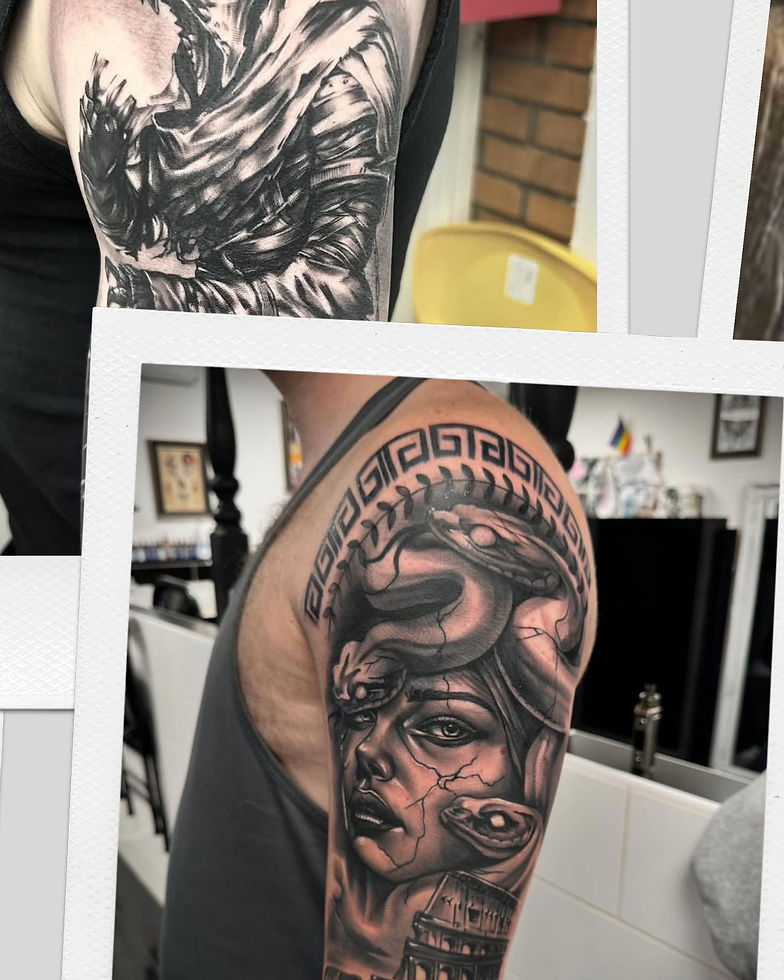
Mastering the Art: Tips for Perfecting Tattoo Shading
- Casey
- Aug 3
- 3 min read
Updated: 5 days ago
Because what separates an average tattooist from a master… is how they handle the shadows.
Let’s get one thing clear: anyone can outline a tattoo. But shading? That’s where the soul of the tattoo lives.
Shading isn’t just a technique — it’s storytelling with depth, mood, and texture. It can make a rose bloom, a skull breathe, or a portrait whisper from skin to soul. If you’re tired of your tattoos looking “flat” or lacking that punch, this blog is your golden needle.
Let’s break down how to turn your shading from decent to jaw-dropping.
Mastering the Art: Elever’s Guide to Tattoo Shading That Speaks

At Elever, we don’t just teach tattoos. We teach artists how to build legacies through skin.
Shading isn’t a filler. It’s a language. A soft whisper. A heavy silence. It conveys the mood behind the masterpiece. It’s how you turn a stencil into a story — and at Elever, we believe if you’re going to tattoo, you do it with purpose.
If you’re learning with us (or thinking about it), this one’s for you. Let’s show you how to shade with confidence, control, and creative fire.
Understanding Shading Techniques
Shading techniques are essential for every tattoo artist. They add dimension and life to your work. There are several methods to consider:
Black and Grey Shading: This technique uses varying shades of black and grey ink. It creates depth and can evoke strong emotions. It’s perfect for portraits and realistic designs.
Colour Shading: Using different colours can bring your tattoos to life. It’s vibrant and can express a range of feelings. Think about how a sunset can change the mood of a landscape tattoo.
Dot Work: This method involves creating images with tiny dots. It’s a unique style that can add texture and detail. It’s often used in mandala designs.
Smooth Shading: This technique blends colours seamlessly. It’s ideal for creating soft transitions. It can make your tattoos look more realistic and polished.
Understanding these techniques will help you choose the right one for your design. Experiment with each to find your unique style.
The Importance of Practice
Practice is vital in mastering shading. It’s not just about technique; it’s about developing your eye for detail. Here are some tips to enhance your practice:
Use Reference Images: Study how light and shadow interact in real life. Look at photographs or even paintings. This will help you understand how to apply shading in your tattoos.
Create Sketches: Before tattooing, sketch your designs. Focus on where the shadows will fall. This will give you a roadmap to follow when you start tattooing.
Work on Fake Skin: Practicing on fake skin allows you to experiment without the pressure of working on a client. It’s a safe space to refine your skills.
Seek Feedback: Share your work with fellow artists. Constructive criticism can help you see areas for improvement.
Building Confidence in Your Shading
Confidence is key when it comes to shading. Here are some strategies to boost your self-assurance:
Start Small: Begin with simple designs. As you gain confidence, gradually take on more complex pieces.
Visualise Success: Before you start tattooing, take a moment to visualise the finished piece. This mental rehearsal can help calm your nerves.
Stay Positive: Remind yourself that every artist has room for growth. Celebrate your progress, no matter how small.
Learn from Mistakes: Mistakes are part of the learning process. Instead of dwelling on them, analyse what went wrong and how you can improve next time.
The Role of Mentorship
Having a mentor can significantly impact your growth as a tattoo artist. A mentor can provide guidance, share their experiences, and help you navigate challenges. Here’s how to find a mentor:
Network: Attend tattoo conventions and workshops. Meet other artists and express your interest in learning from them.
Join Online Communities: There are many online forums and social media groups for tattoo artists. Engage with others and seek out experienced artists who may be open to mentorship.
Be Open to Feedback: When you find a mentor, be receptive to their advice. They have valuable insights that can help you improve.
Conclusion: Your Journey Begins Here
Shading is an art form that requires practice, patience, and passion. At Elever, we’re dedicated to helping you master this skill. Remember, every great tattoo artist started where you are now. With determination and the right guidance, you can elevate your shading from ordinary to extraordinary.
If you’re ready to take the next step in your tattoo journey, consider joining us at Elever Training Institute. We’re here to support you as you build your legacy through skin.
Let’s make your tattooing dreams a reality!









Comments